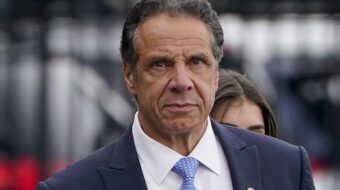
On the color-coded 2004 election maps, New York was blue — not a big surprise. Yet many “red” areas dot the state’s political maps, including nine Republican congressional districts, the Statehouse (held by three-term Republican Gov. George Pataki) and the Republican-controlled state Senate.
But, as Bob Dylan sang, “The times, they are a-changing.”
New Yorkers have every reason to expect a big sweep for the Democrats in November, starting with the governor’s and U.S. Senate races, on down to the state Senate.
Extremely important for the national picture are the congressional races. It looks like New York voters will contribute at least one and maybe more seats to the 15-seat change necessary to end Republican control of Congress.
Die-hard Republican Tom Reynolds in western New York will again face Jack Davis, who got 44 percent of the vote in 2004 in this 2-to-1 Republican district. On the other end of the state, Kirsten Gillebrand, an attorney, is running for the 2006 party nomination to challenge GOP incumbent John Sweeney.
In New York City, Vito Fossella may face a challenge from City Councilman Bill deBlasio. If this happens — and it’s safe to say that labor and the city’s many liberal and progressive forces would love such an opportunity — Fossella will be in trouble.
In a district that includes southern and central parts of the state, “Band of Brothers” candidate Eric Massa is challenging Republican Randy Kuhl. Massa writes about the area, “It is hard to drive more than a few miles and not see a vacant factory or abandoned farm.”
Last week, incumbent Sherwood Boehlert announced he would not run for re-election. What had been considered a safe Republican seat may not be so safe — in 2000, Bush won this district by only 1 percentage point, and in 2004, by only 6 points. As one observer commented, “Assuming a decent candidate, any open congressional House race in New York is winnable for the Dems.”
Why? Across the state, there is growing opposition to the Republican agenda and anger at its local impact. From tax cuts for the rich, to the attack on Social Security and disastrous Medicare policy, to the deep cuts in social program spending, to the war in Iraq, New Yorkers are not happy with the direction of the country.
This unhappiness has roots in the growing economic problems facing working people struggling to heat their homes, pay some of the highest property taxes in the nation, and make ends meet as good jobs disappear and public services are drastically cut.
It has roots in those poorer, rural parts of the state that some have compared to Appalachia, but it also has roots in the suburbs, including Long Island, no longer the Republican stronghold it once was. A very important victory was the election last year to the Suffolk County Legislature of a bus driver and transit union member who ran on the Democratic and Working Families Party lines.
Unhappiness with the Bush gang also has deep roots in all parts of New York City. The attack on labor, cuts in aid to veterans and first responders, and anti-immigrant policies added to growing poverty, a public education system in crisis, skyrocketing housing costs and relentless gentrification of working-class neighborhoods — all these are big issues here and will play out in November.
The war in Iraq isn’t too popular either. Parents, and not just on the liberal Upper West Side of NYC, but in rural areas as well, are organizing against the aggressive tactics of military recruiters in high schools. A New York Times article described that opposition in small-town New York, quoting a recruiter who said, in the past, “perhaps 1 or 2 of 10 parents would hang up; now, people hang up all the time.”
Finally, there is another race which gives New Yorkers an opportunity to add strength and depth to the fight against the extreme right: the race to fill the seat of retiring progressive Congressman Major Owens. Given what’s at stake — someone once said that the right wing wants to “overthrow the 20th century” — we need someone who will be a fighter like Owens. Of the Democratic contenders, clearly Chris Owens would continue that record and build on his own as a lifelong community activist and supporter of labor, women’s rights, gay rights, public education, and very importantly for the future of Brooklyn, the right of working people to live in NYC.
The anger and dissatisfaction with the national Republican agenda will also be expressed in the state Senate elections, where the Republican majority, cut to only four seats in 2004, could shrink even further this year.
What this will add up to in November depends on many things: how fast and how low Bush’s popularity will sink; how united and focused labor and the people’s movements are; and how mobilized the people are on the issues, on what’s at stake.
This election is, plain and simple, a referendum on the Bush administration and its policies. Winning it means electing Democrats, including some who are not good on every issue. Changing the state’s congressional map — making it bluer — is a necessary part of making that referendum an unmistakable rejection of the Bush agenda.
Elena Mora (emora@cpusa.org) is state chairperson of the Communist Party of New York.









